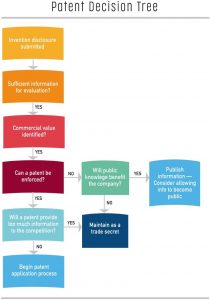Trade Secrets over Patents? What is the Right Choice for You?
 Posted On
Posted On
When we talk about safeguarding some specific piece of information that adds to the commercial value of the goods, two obvious options come to our minds. The first is trade secrets, and the second is patents. The choice between the two options widely depends on the type of enterprise, the nature of operations undertaken by such an enterprise, and the value of the subject matter to be protected.
Uncovering Trade Secrets
A trade secret is a practice or process belonging to an entity, which is not made publicly known to anyone outside the entity. Such a piece of information is capable of adducing additional benefits to the company, which gives it an economic edge over its competitors in the like business. The trade secret in question is usually the product of intensive internal research and development. The three-prong test to qualify a secret as a trade secret is:
- A company should make reasonable efforts in concealing the information from the public;
- The secret must intrinsically have some economic value in itself or add to the existent economic value; and
- The trade secret must contain information not known to the public, which makes it a viable secret. The secret can be technical, like manufacturing processes, pharmaceutical test data, designs, and drawings of computer programs, or it can be commercial, like distribution methods, a list of suppliers and clients, and advertising strategies. It can also be a combination of both.
Trade secrets are usually protected through laws addressing unfair competition or sui generis laws. For example, the United States safeguards its trade secrets through the Economic Espionage Act of 1996 as well as through the Uniform Trade Secrets Act (USTA), which has been adopted by a majority of States. Another mode of protection could be through enforcement of the law against industrial or commercial espionage, breach of contract, and breach of confidence.
Let us consider a few examples of relevant trade secrets that several entities have secured successfully over the years.
- The secret formula of Coca-Cola is locked in a bank vault. Since the same has not been patented, it has never been revealed publicly. The same approach has been taken by KFC.
- Google Inc.’s search algorithm is also existent as its Intellectual Property (IP) in the form of a trade secret over its code, which is regularly updated to improve and protect its operations.
- The New York Times Bestseller list does factor in book sales by collecting and compiling chain and independent store sales, as well as wholesaler data. The list is not just sales numbers. The method of enlisting, although reliable, is, however, unknown.

Weighing the Advantages and Disadvantages of Trade Secrets
| S. No. |
Advantages |
Disadvantages |
| 1 | Trade secrets are inexpensive to secure because they do not mandate a registration process or supplemental fee. | If a trade secret is made publicly available through a company’s actions or its failure to take reasonable steps to protect it, it loses the said protection. |
| 2 | Trade secrets retain their protection as long as they are not revealed in public. | The biggest disadvantage lies in the fact that if a product or process is reverse-engineered, it won’t remain a trade secret for long, and in addition to the same, it won’t attract any liability. |
| 3 | Trade secrets have an instant effect since there is no processing time for their protection to be enforced. | If a competitor develops the process or product that you are withholding as a trade secret on your own, it is free to use the process without any legal implications. |
| 4 | Trade secrets do not have to comply with any required governmental authority or disclosures as in other IPRs due to the absence of third-party involvement. | Trade secrets can be difficult to enforce when compared to other kinds of Intellectual Property Rights (IPRs) as one will need to demonstrate that the person using the information had obtained it unlawfully from someone with access to the proprietor’s trade secret. |
| 5 | Trade secrets can protect an ‘abstract idea,’ including software designs, source codes, and algorithms. | |
| 6 | The scope of protection and the ambit of subject matters governed under trade secrets are more extensive than other IPRs. |
Choosing between Patents and Trade Secrets
There is a thin line between patents and trade secrets, and therefore, choosing between either of the two is a fundamental decision for all entities alike. The USPTO views that trade secret protection is an alternative to Patent Protection. To draw a sharp contrast between the two, let’s look at them closely:
Patents
- The invention should be a new addition to state of the art such that it is non-obvious and industrially applicable.
- The grant of a patent gives the patent holder a right to exclude others from making, selling, using, or importing the invention.
- The disclosure of the invention has to be made public so that after the expiry of the term of the patent, the same can facilitate public benefit and improved incremental innovations.
- It usually takes 2-3 years to receive patent protection.
- The term of protection is 20 years.
- The cost of securing patents is relatively higher than any other IP.
Trade secrets
- A trade secret protects any commercially viable secret of varying nature.
- The owner of a trade secret can enjoy the same rights as that of a patentee but at his or her own risk. A trade secret protects only against the misappropriation of secrets.
- There is no need for disclosure of information in this case.
- The time to secure trade secret protection is continuous and perpetual since an internal procedure has to be maintained to ensure secrecy.
- The term of protection is perpetual.
- The cost of protection is relatively much lower than that of patents.
The question of choosing either of the two mechanisms was discussed in the case of Kewanee Oil Co. vs. Bicron Corp., where it examined the question under three different categories.
- “The trade secret believed by its owner to constitute a validly patentable invention;
- The trade secret is known to its owner but not to be so patentable; and
- The trade secret whose valid patentability is considered doubtful.”
In the first instance, the proprietor has to make a balanced and informed choice. In the second instance, the proprietor should opt for a trade secret since the Patent Law would be inapplicable. For the last category, the court held that “eliminating trade secret law for the doubtfully patentable invention has deleterious effects on society“ and thus, presents no conflict with patent law. Therefore, trade secrets could pose to be a better solution since society would be at a loss if the same is not made available to the public only because patent law does not permit it.

Points of Consideration
Although the choice between trade secrets and patents depends on the entity seeking such protection; however, before opting for trade secret protection, the entity should take into consideration the following:
- Always consider the option of patenting before completely ruling it out. If a subject matter is not patentable, an entity’s resources can be better spent on trade secret protection. And vice-versa applies in the case if the information is not capable of being kept as a trade secret, where a patent may be the only recourse for better protection.
- If you believe that the secret can be safely safeguarded and that with time, the information can be altered for the better benefit, trade secret protection should be opted for since patents limit the idea of ‘ever greening’ of patented information.
- As a disadvantage, proving the misappropriation of trade secrets can be rather an arduous route. Therefore, where the information is vulnerable and has the chance of discovery through research by another, the patent option should be sought.
- The disclosure of patent information means that rivals can invent around the said patent to harm the inventor. The same may be critical in the case of trade secrets. How can one mark multiple barriers around a trade secret dealing with, say, a recipe to circumvent its application? The chances are a bare minimum. Therefore, such decisions call for careful consideration and consultation with informed IP strategists and advocates. ✅ For more visit: https://www.kashishipr.com/

